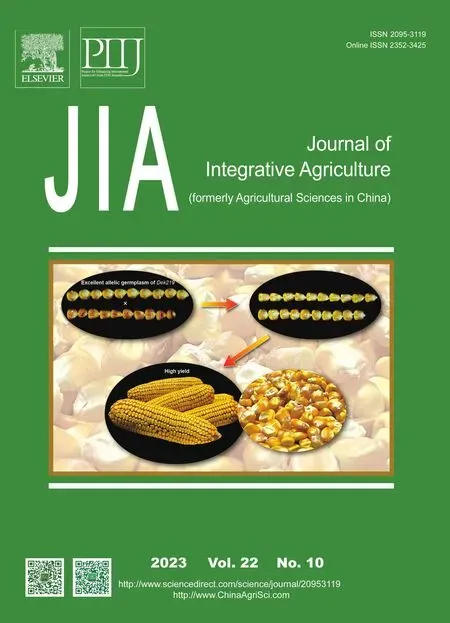Optimizing water management practice to increase potato yield and water use efficiency in North China
2023-10-16LIYangWANGJingFANGQuanxiaoHUQiHUANGMingxiaCHENRenweiZHANGJunHUANGBinxiangPANZhihuaPANXuebiao
LI Yang ,WANG Jing# ,FANG Quan-xiao ,HU Qi ,HUANG Ming-xia ,CHEN Ren-wei ,ZHANG Jun,HUANG Bin-xiang,PAN Zhi-hua,PAN Xue-biao
1 College of Resources and Environmental Sciences,China Agricultural University,Beijing 100193,P.R.China
2 Agronomy College,Qingdao Agricultural University,Qingdao 266109,P.R.China
3 Inner Mongolia Academy of Agricultural and Animal Husbandry Sciences,Hohhot 010031,P.R.China
Abstract Potato is one of the staple food crops in North China. However,potato production in this region is threatened by the low amount and high spatial-temporal variation of precipitation. Increasing yield and water use efficiency (WUE) of potato by various water management practices under water resource limitation is of great importance for ensuring food security in China. However,the contributions of different water management practices to yield and WUE of potato have been rarely investigated across North China’s potato planting region. Based on meta-analysis of field experiments from the literature and model simulation,this study quantified the potential yields of potatoes without water and fertilizer limitation,and yield under irrigated and rainfed conditions,and the corresponding WUEs across four potato planting regions including the Da Hinggan Mountains (DH),the Foothills of Yanshan hilly (YH),the North foot of the Yinshan Mountains (YM),and the Loess Plateau (LP) in North China. Simulated average potential potato tuber dry weight yield by the APSIM-Potato Model was 12.4 t ha–1 for the YH region,11.4 t ha–1 for the YM region,11.2 t ha–1 for the DH region,and 10.7 t ha–1 for the LP region,respectively. Observed rainfed potato tuber dry weight yield accounted for 61,30,28 and 24% of the potential yield in the DH,YH,YM,and LP regions. The maximum WUE of 2.2 kg m–3 in the YH region,2.1 kg m–3 in the DH region,1.9 kg m–3 in the YM region and 1.9 kg m–3 in the LP region was achieved under the potential yield level. Ridge-furrow planting could boost yield by 8–49% and WUE by 2–36% while ridge-furrow planting with film mulching could boost yield by 35–89% and WUE by 7–57% across North China. Our study demonstrates that there is a large potential to increase yield and WUE simultaneously by combining ridge-furrow planting with film mulching and supplemental irrigation in different potato planting regions with limited water resources.
Keywords: potential yield,irrigated yield,rainfed yield,ridge-furrow,film mulching,APSIM
1.Introduction
Potato is the world’s fourth largest food crop after maize,wheat,and rice (FAO 2016). China has been the leading potato producer since 1993 with total production and planting area accounting for 25.1 and 29.6% of the world total,respectively (FAO 2016;Liet al.2022a). Over a half(53.9%) of China’s potato production is in North China(Janskyet al.2009;Yanget al.2018;Tanget al.2019).Limited and highly variable natural precipitation is the key limiting factor of potato production in North China (Xiaoet al.2013;Zhaoet al.2014;Liet al.2022c).
To reduce the climatic risk during the potato growth period and increase potato yield and water use efficiency(WUE) in arid and semi-arid regions,farmers usually use various water management practices,such as ridgefurrow planting,film mulching,and supplemental irrigation(Huet al.2014;Zhaoet al.2014;Jiet al.2018;Tanget al.2019). Supplemental irrigation has been recognized as a most effective strategy for increasing potato yield (Panet al.2007;Tanget al.2019). For example,Tanget al.(2018) found that 8 to 55 mm of supplemental irrigation could increase potato yield by 19.4,24.4 and 30% and WUE by 12,18.8 and 19.1%,in the eastern,middle,and western agro-pastoral areas of North China,respectively(Tanget al.2018).
For arid and semi-arid regions with limited water resource,irrigation pumping from groundwater is not a sustainable way of increasing yield and ensuring yield stability (Huet al.2015). Therefore water management practices such as ridge-furrow planting and film mulching are widely used to improve yield and WUE (Chenet al.2017;Liuet al.2018). Compared with rainfed flat planting,yield and WUE of potato may be enhanced by 22.5 and 9.7%,respectively,under film mulching at Zhuanglang in Gansu Province,and by 12.3 and 18%,respectively,under ridge-furrow planting at Wuchuan in Inner Mongolia (Gaoet al.2014;Huet al.2014). The high variability of yield and WUE of potato in response to these water management practices is associated with large spatial heterogeneity in rainfall conditions across North China,which may be better explored by combining field experimental results and model simulations to provide a reference for farmers to compare agricultural water utilization and field management practices (Panet al.2007;Huet al.2013). Moreover,determination of yield gaps and WUE gaps between potential,irrigated and rainfed conditions could help farmers understand the increasing potential of yield and WUE and develop feasible water management practices for North China’s potato production. The hypothesis of our study is that the effects of water management practices on yield and WUE of potato are strongly dependent on climate and therefore the priority of selecting water management practices would be significantly different across North China. Therefore,the objectives of the study were to:1) quantify the potential yield,irrigated yield,rainfed yield,and their corresponding WUE for potato in North China,and 2) quantify the contributions of ridge-furrow planting,ridge-furrow planting with film mulching,and supplemental irrigation to yield and WUE of potato to aid selection of appropriate water management practices in North China.
2.Materials and methods
2.1.Study area,experimental site,and historical climate
Based on different climate conditions,the potato planting region in North China is divided into four planting regions: the Da Hinggan Mountains (DH),the Foothills of Yanshan hilly (YH),the North foot of Yinshan Mountains(YM),and the Loess Plateau (LP) (Fig.1) (Liuet al.2022). Historical climate data at the experimental sites,including daily maximum and minimum temperatures(°C),precipitation (mm),and sunshine hours (h),were obtained from China Meteorological Administration(https://www.cma.gov.cn/). Daily solar radiation was calculated from daily sunshine hours based on the Ångström equation (Wanget al.2015;Heet al.2020;Liet al.2022b). Growing season (April to September) solar radiation,mean temperature and precipitation averaged from 1981 to 2015 at typical sites for DH (Qiqihaer),YH(Chifeng),YM (Hohhot),and LP (Yulin) are shown in Fig.2.The YH,YM,and LP regions have similar growing season solar radiation and precipitation while the DH region has lower growing season solar radiation and higher growing season precipitation than the other three sites. Growing season mean temperature in the LP region is the highest.
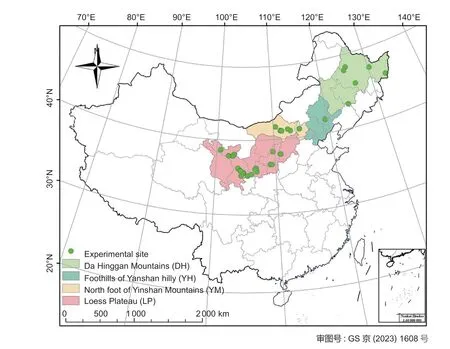
Fig.1 Potato planting regions in North China including the Da Hinggan Mountains (DH),the Foothills of Yanshan hilly (YH),the North foot of Yinshan Mountains (YM),and the Loess Plateau (LP) regions,and the experimental sites selected in each region.

Fig.2 Total solar radiation,mean temperature,and total precipitation during the potato growing season (April to September) from 1981 to 2015 in the Da Hinggan Mountains (DH),the Foothills of Yanshan hilly (YH),the North foot of Yinshan Mountains (YM),and the Loess Plateau (LP) regions. The box whiskers show the maximum and minimum values;the upper and lower box edges of boxes show the 75th and 25th percentiles,respectively;the interior horizontal bar shows the median;the red solid circle shows the average value.
2.2.Data resource for meta-analysis
To investigate the yield and WUE of potato in response to different water management practices in North China,data including yield,evapotranspiration (ET),and WUE of potato under different agronomic management practices were collected using the Web of Science,Google Scholar,and China National Knowledge Infrastructure (https://www.cnki.net) from 2000 to 2020 with the keywords of “potato,yield or water use efficiency,and North China”. Three criteria were applied to ensure that minimum scientific standards were met: 1)potato WUE was calculated as tuber yield/growth period evapotranspiration,2) the experimental treatments(flat planting,ridge-furrow planting,and film mulching)were conducted at planting,and 3) ET was recorded by the study otherwise it was calculated by available meteorological and phenological data. A total of 145 field experimental data at 29 experimental sites from 56 peerreviewed papers with data of potato yield,ET,and WUE were collected across the four regions (Appendices A and B). For comparison with simulated yield by modelling,fresh potato yield was multiplied by 20% to convert to tuber dry weight (Donget al.2012;Liet al.2021).
2.3.Different yield levels
The study considered three yield levels,i.e.,the potential yield (Yp),the irrigated yield (Yi240,Yi160,andYi80),and the rainfed yield (Yr) (Fig.3). Due to lack of detailed field experimental data to compare across different potato planting regions,the potential and irrigated yields of potato were simulated by the APSIM-Potato Model while the rainfed yield was collected from the field experiment data in this study.Ypwas defined as the highest yield that the modern potato cultivar can achieve without stresses of water,nutrient,pests and insects,and with optimal planting date.Ypis determined by solar radiation,temperature,CO2concentration,and crop characteristics (Liet al.2022a,c).Yi240,Yi160,andYi80were the yields with the supplemental irrigation amounts of 240,160,and 80 mm achieved without nutrient deficiency,pest,and insect stresses (Liet al.2019).Yrwas the rainfed experimental yield without nutrient deficiency,pest,and insect stresses under flat planting,ridge-furrow planting,and ridge-furrow planting with film mulching. The gap between the potential yield and rainfed yield (YGpr) was calculated to analyze the yieldincreasing potential for potato in North China:
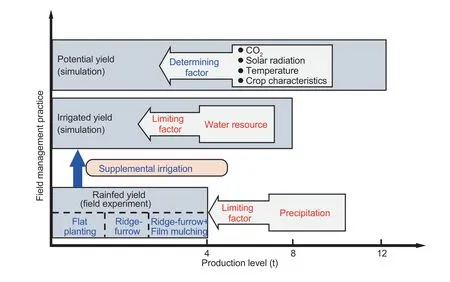
Fig.3 Definition of potato yield levels under different water limitation conditions in North China.
2.4.APSlM-Potato Model parameterization and model setting
As a process-based crop model,the APSIM-Potato(version 7.6) Model has been validated across China’s potato planting regions,especially in North China,by our previous studies (Liet al.2020,2021,2022a;Tanget al.2021). The APSIM-Potato Model performed well in simulating potato phenology with root mean square errors(RMSEs)<6.3 days,LAI with relative root mean square errors (RRMSEs)<23%,biomass with RRMSEs<29%,soil water content to 1 m depth with RRMSEs<32%,and potential,irrigated,and rainfed fresh potato yields with RRMSEs of 12,16 and 23%,respectively,based on field experiments. The detail information for the field experiments,statistical metrics for model evaluation,model performance,and the calibrated cultivar parameters of potato could be found in Liet al.(2020,2021,2022a)and Tanget al.(2021).
For simulating the potential and irrigated potato yields,the local late-maturing potato cultivar Kexin_1 was chosen and the planting date was set as May 15 (Yu and Wang 2015;Liet al.2020). For simulating the potential yield,irrigation and nitrogen fertilization were applied automatically to avoid any water and nitrogen stresses(Liet al.2022a). For simulating the irrigated yield,the planting density was set as 5 plants m–2and 37.5 kg ha–1of nitrogen fertilizer was applied at planting (Liet al.2021).Three irrigation scenarios were applied during the potato growth period as 40 mm at emergence and 40 mm at early tuber (Yi80),40 mm at planting,40 mm at emergence,40 mm at early tuber,and 40 mm at senescing (Yi160),and 40 mm at planting,40 mm at emergence,80 mm at early tuber,and 80 mm at senescing (Yi240).Regional yield and WUE were simulated based on the average of simulated values from different experimental sites in each region.
2.5.ET and WUE of potato
Potato ET (mm) in the field experiments,including plant transpiration and soil evaporation,was calculated according to the soil water balance equation:
wherePwas the growth period precipitation (mm),Iwas the irrigation amount (mm),ΔWwas the difference in soil water content at the root layer from planting to maturing(mm),Rwas the runoff amount (mm),andDwas the water infiltration amount (mm). Simulated ET was an output of the APSIM-Potato Model.
WUE (kg m–3) was the ratio of tuber dry weight (Y,kg ha–1) to ET (mm):
where 0.1 was the unit conversion coefficient.
2.6.Change rate of yield and WUE of potato in response to different water management practices
The main water management practices in North China’s potato planting regions include rainfed flat planting (RY),ridge-furrow planting (RF),ridge-furrow planting with film mulching (RF+FM),and supplemental irrigation (SI)(Fig.4). Change rates of yield and WUE of potato in response to different water management practices were calculated as:

Fig.4 Diagram of different water management practices in the semi-arid region.
where ΔCRF,ΔCSI,and ΔCRF+FMrepresent the change rates of yield and WUE of potato in response to RF,SI and RF+FM,respectively,compared with rainfed flat planting.YRF,YSI,YRF+FM,andYRYrepresent the tuber dry weight (t ha–1) and WUE (kg m–3) under RF,SI,RF+FM,and RY,respectively.
3.Results
3.1.Yield levels and their ET
Simulated average potential potato tuber dry weight yield was 12.4,11.3,11.2 and 10.7 t ha–1in the YH,YM,DH and LP regions,respectively. The average ET under potential condition was 597,525,558 and 574 mm in the YM,DH,YH and LP regions,respectively (Fig.5-B).Observed rainfed potato tuber dry weight yield of 6.8,3.6,3.2 and 2.6 t ha–1accounted for 61,30,28 and 24%of the potential yields in the DH,YH,YM and LP regions,respectively. The average ET was 422 mm in the DH region,250 mm in the YH region,266 mm in the YM region,and 279 mm in the LP region. Compared with yields under the rainfed condition,irrigation amounts of 80,160 and 240 mm could increase potato yield by 66,148 and 211% in the YH region,39,114 and 189% in the LP region,32,96 and 155% in the YM region,and 20,36 and 42% in the DH region,respectively. The ET under the irrigation amounts of 80,160 and 240 mm could be increased by 49,79 and 105% in the YH region,29,58 and 85% in the YM region,15,43 and 69% in the LP region,and 4,13 and 17% in the DH region,respectively.
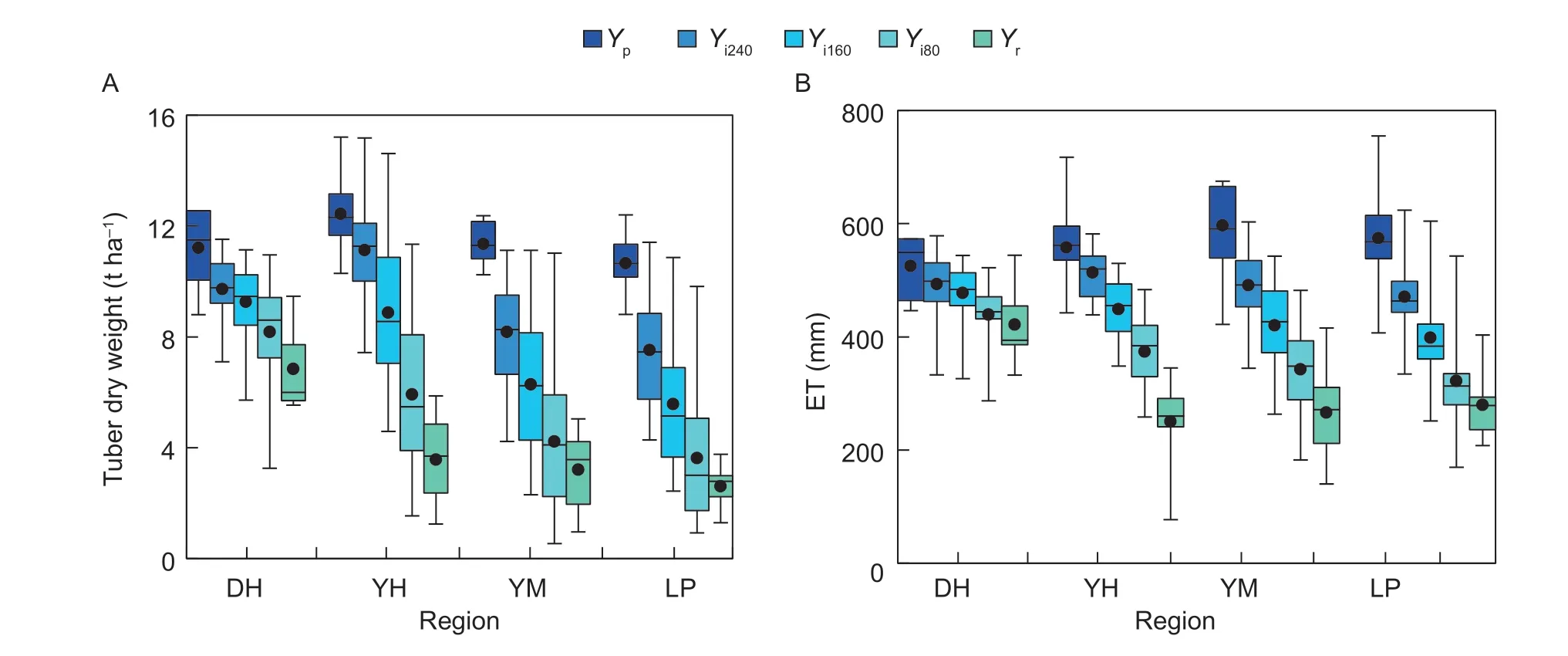
Fig.5 Tuber dry weight and evapotranspiration (ET) under the potential (Yp,simulated from 1981–2015),supplemental irrigation amount of 240,160,and 80 mm (Yi240,Yi160 and Yi80,simulated from 1981–2015),and rainfed yield (Yr) levels in the Da Hinggan Mountains (DH,8 experimental data),the Foothills of Yanshan hilly (YH,17 experimental data),the North foot of Yinshan Mountains(YM,33 experimental data),and the Loess Plateau (LP,22 experimental data) regions. The box whiskers show the maximum and minimum values;the upper and lower box edges show the 75th and 25th percentiles,respectively;the interior horizontal bar shows the median;the black solid circle shows the average value.
3.2.WUE
Under the potential yield level,the highest WUE was 2.2,2.1,1.9 and 1.9 kg m–3in the YH,DH,YM and LP regions,respectively (Fig.6). The highest WUE under the rainfed yield level was 1.7 kg m–3in the DH region followed by 1.5 kg m–3in the YH region,1.2 kg m–3in the LP region and 0.9 kg m–3in the YM region. Under the irrigation amounts of 240 and 160 mm,higher WUEs of 2.2 and 2 kg m–3,respectively were achieved in the YH region than in other regions. Under the irrigation amount of 80 mm,the highest WUE of 1.8 kg m–3was achieved in the DH region,followed by 1.5 kg m–3in the YH region,1.3 kg m–3in the YM region,and 1 kg m–3in the LP region.
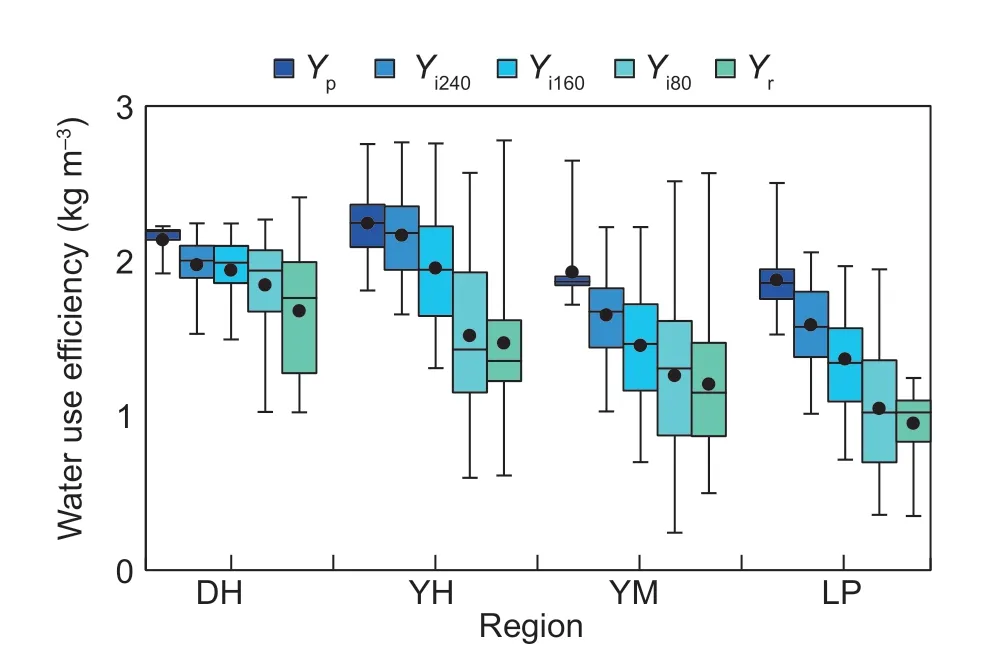
Fig.6 Water use efficiency under the potential (Yp,simulated from 1981–2015),supplemental irrigation amounts of 240,160,and 80 mm (Yi240,Yi160,Yi80,simulated from 1981–2015),and rainfed yield (Yr) levels simulated by the APSIM-Potato Model in the Da Hinggan Mountains (DH,8 experimental data),the Foothills of Yanshan hilly (YH,17 experimental data),the North foot of Yinshan Mountains (YM,33 experimental data),and the Loess Plateau (LP,22 experimental data) regions. The box whiskers show the maximum and minimum values;the upper and lower box edges show the 75th and 25th percentiles,respectively;the interior horizontal bar shows the median;the black solid circle shows the average value.
3.3.Change rates of yield and WUE of potato in response to different water management practices
Compared with flat planting under the RY,RF could boost yield and WUE by 18 and 25% in the DH region,19 and 10% in the YH region,24 and 20% in the YM region and 49 and 36% in the LP region,respectively(Fig.7-A and C). RF+FM could increase potato yield and WUE by 35 and 34% in the DH region,71 and 16% in the YH region,72 and 46% in the YM region and 89 and 57% in the LP region,respectively,compared with RY.Potato yield increased almost linearly up to the irrigation amount of 240 mm in the DH region,330 mm in the YH region,and 360 mm in the YM and LP regions (Fig.7-B).Within the irrigation amount of 240 mm in the DH region,180 mm in the YH region,and 330 mm in the YM and LP regions,simulated potato WUE increased almost linearly(Fig.7-D).
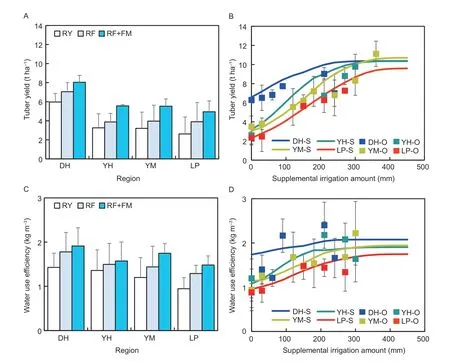
Fig.7 Comparisons of yield (A) and water use efficiency (C) under rainfed flat planting (RY,80 experimental data points),ridgefurrow planting (RF,47 experimental data points),and ridge-furrow planting with film mulching (RF+FM,18 experimental data points),and the response of simulated (from 1981–2015) and observed (23 experimental data points) yields (B) and water use efficiencies (D) to different supplemental irrigation amounts in the Da Hinggan Mountains (DH),the Foothills of Yanshan hilly (YH),the North foot of Yinshan Mountains (YM),and the Loess Plateau (LP) regions. S and O represent the simulated and observed values,respectively. The error bars indicate the standard errors (n=145).
4.Discussion
North China is one of the world’s most important potato planting regions (Janskyet al.2009;Wanget al.2018;Tanget al.2019). Simulated average potential potato tuber dry weight of 11.3 t ha–1in North China was higher than that in other potato planting regions in China due to higher solar radiation and more suitable temperature conditions (Wanget al.2018;Liet al.2022a). However,the potential yield of potato in China is lower than that in several potato planting regions,such as Iran (13.5 t ha–1),France (12.4 t ha–1),and Peru (12.4 t ha–1) (Supitet al.2010;Gradoset al.2020;Dadrasiet al.2022).
In general,observed potato tuber dry weight of 4.1 t ha–1averaged across China is lower than that in other dominant potato production countries such as New Zealand (9.9 t ha–1),the Unites States (8.3 t ha–1),the Netherlands (9.1 t ha–1),and Canada (7.7 t ha–1) (FAO 2016;Wanget al.2018;Liet al.2022a). The large yield gaps between China and these countries has been attributed to inferior seed quality,frequent pests and diseases,and low water and fertilizer use efficiency in China’s potato industry (Janskyet al.2009;Wanget al.2018;Gaoet al.2019). Although a large amount of water and nitrogen-saving options have been widely used in potato production by large growers,low water and nitrogen use efficiency exists in China’s potato industry due to dominant production by small growers (Onderet al.2005;Ierna and Mauromicale 2018;Michaelet al.2018). For example,potato WUE in New Zealand (1.7 to 2.5 kg m–3) is higher than in China (1.4 to 1.6 kg m–3)(Liet al.2015,2022a;Fandikaet al.2016). Nitrogen use efficiency may achieve 59 to 63% in Canada but is generally lower than 50% in North China (Zebarthet al.2004;Yanget al.2021;Shenet al.2022). Across North China’s potato planting regions,rainfed yield and WUE accounted for 24–61 and 51–78% of the yield and WUE under the potential yield level (Appendix C). Therefore,optimizing agronomic management practices to maximize water and nitrogen use efficiency is urgently needed to improve China’s potato production.
Among North China’s potato planting regions,the DH region achieved the highest rainfed potato yield due to higher growing season precipitation than other planting regions (Janskyet al.2009;Liet al.2022a,c). However,mean growing season precipitation of 380 mm in this region is still lower than the water requirement of 450–500 mm for potato growth (Wuet al.2009;Yanget al.2010;Xieet al.2012). Therefore,supplemental irrigation is recognized as the most effective way of increasing crop yield (Tanget al.2018;Shenet al.2020). Usually,famers apply supplemental irrigation for two to four times (about 100–300 mm) by pumping groundwater for increasing potato yield and maximizing economic benefits (Huet al.2013;Qinet al.2013). However,a large amount of irrigation from groundwater has resulted in serious environmental impacts such as soil salinization and groundwater depletion (Zhuet al.2014;Zhanget al.2016;Xiaoet al.2017),which are threatening the sustainability of agricultural production and water resource conservation in North China (Xiaet al.2010). Our results showed that 80–240 mm of supplemental irrigation could increase rainfed yield much more (39 to 211%) in the YH,YM,and LP regions than in the DH region (20 to 42%;Liuet al.2019). Therefore,in the middle and western potato planting regions of North China,a high potential tradeoffbetween supplemental irrigation and water resource conservation is a focus of agricultural production (Yanget al.2010;Liet al.2022a).
Other water-saving management practices,such as ridge-furrow planting and film mulching,are widely used in arid and semiarid regions to improve yield and WUE by increasing crop transpiration while decreasing soil evaporation (Reizet al.1988;Tianet al.2003;Huet al.2017). Our study found that ridge-furrow planting could increase yield by 18–49% and WUE by 10–36%compared with rainfed flat planting in North China,which is equal to the effect of applying supplemental irrigation amounts of 30 to 120 mm. However,the yield increase from flat planting to ridge-furrow planting in the DH region was lower than that in other regions because of higher precipitation in the DH region (Liuet al.2019). Combining ridge-furrow planting and film mulching could increase potato yield by 34–89% and WUE by 16–57% above that of rainfed flat planting,which was equal to the effect of applying supplemental irrigation amounts of 90 to 180 mm in North China. Among the four regions,ridge-furrow planting and ridge-furrow planting with film mulching performed better in increasing yield and WUE of potato in the LP region than in the other regions. This is because the LP region has higher soil evaporation and lower precipitation than the other regions and therefore ridgefurrow planting and film mulching produce a relatively greater improvement in yield and WUE by reducing soil evaporation and increasing crop water use (Qinet al.2014;Zhaoet al.2014).
In general,WUE would not increase with rising yield where water supply exceeds water demand when a large amount of irrigation water is applied (Luet al.2019;Liet al.2022a). However,field experiment and simulation studies in North China’s potato region have shown that the WUE increased with increasing potato yield,which demonstrated that yield and WUE of potato could be synergistically enhanced by adopting water management practices with limited amounts of irrigation(Fig.8). Moreover,previous studies have shown that the synergistical enhancement of yield and WUE under ridgefurrow planting and film mulching also happens in canola,maize,and sunflower in semi-arid regions,suggesting that ridge-furrow planting and film mulching should be promoted in agricultural production in arid and semiarid regions (Yanet al.2012;Guet al.2016;Wanget al.2020).
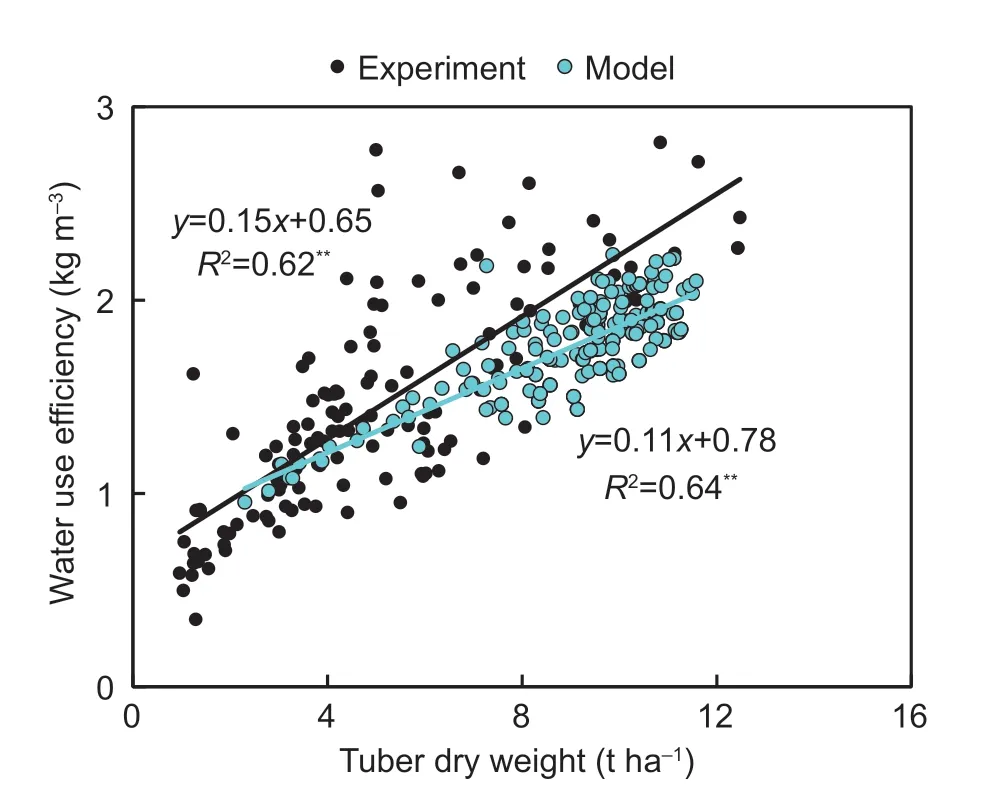
Fig.8 Relationship between tuber dry weight and water use efficiency observed in the field experiments and simulated by the APSIM-Potato Model. **,P<0.01.
There were several limitations in our study. Firstly,limited experimental data restricted the comparisons of yield and WUE of potato under different irrigation levels. Therefore,our study used a crop model to mimic the impacts of irrigation amount on yield and WUE of potato in different planting regions. Simulated rainfed yields matched well with observed rainfed yields,which further verified the accuracy of the APSIM-Potato Model(Fig.7). However,the APSIM-Potato Model could not currently simulate the effect of ridge-furrow planting and film mulching on potato yield and WUE. In the future,the model should develop the module of ridge-furrow and film mulching to investigate their impacts on potato growth and development (Wanget al.2020;Zhanget al.2020).Secondly,our study found that simulated potato yield from the APSIM-Potato Model would increase continuously with increase in irrigation amount. However,potato yield may decrease when irrigation amount exceeds the maximum water demand because of N leaching (Woliet al.2016;Tanget al.2021). Thirdly,our study could not reveal the interaction of different water management practices in different planting regions due to data limitation. Previous studies have shown that there was an interaction between ridge-furrow planting,film mulching,and supplemental irrigation (Qinet al.2014;Zhaoet al.2014). Finally,other water management practices such as crop rotation,conservation tillage,and selection of drought-resistant cultivars could also increase potato yield and WUE,which needs to be considered in future studies (Saluzzoet al.1999;Xiaoet al.2020).
5.Conclusion
The low amount and high variation of growing season precipitations result in high variation and low amount of yield and WUE of potato in North China under rainfed conditions. Ridge-furrow planting and ridge-furrow planting with film mulching could narrow the yield gap between potential and rainfed yield levels by 9–25 and 24–47%,respectively,and the corresponding WUE gap could be narrowed by 6–50 and 21–76%,respectively.Yield and WUE could be synergistically enhanced by ridge-furrow planting,ridge-furrow planting with film mulching,and supplemental irrigation in the region.The results of the study provided a scientific reference for increasing the yield and WUE of potato in arid and semiarid regions and improving crop model functioning in simulating the effects of ridge-furrow planting and film mulching on crop yield and WUE. Future work could explore the interaction effect of ridge-furrow planting,film mulching,and supplemental irrigation on yield and WUE based on an improved crop model,and analyze the effects of these water management practices on potato production in other potato planting regions in China.
Acknowledgements
The work was supported by the National Key Research and Development Program of China (2021YFD1901104)and the 2115 Talent Development Program of China Agricultural University (00109016). We would like to thank China Meteorological Administration for providing the historical climate data. The authors acknowledge the anonymous referees for their valuable comments.
Declaration of competing interest
The authors declare that they have no conflict of interest.
Appendicesassociated with this paper are available on https://doi.org/10.1016/j.jia.2023.04.027
杂志排行
Journal of Integrative Agriculture的其它文章
- The association between the risk of diabetes and white rice consumption in China: Existing knowledge and new research directions from the crop perspective
- Linking atmospheric emission and deposition to accumulation of soil cadmium in the Middle-Lower Yangtze Plain,China
- Genome-wide association study for numbers of vertebrae in Dezhou donkey population reveals new candidate genes
- Are vulnerable farmers more easily influenced? Heterogeneous effects of lnternet use on the adoption of integrated pest management
- lnfluences of large-scale farming on carbon emissions from cropping:Evidence from China
- Spatio-temporal variations in trends of vegetation and drought changes in relation to climate variability from 1982 to 2019 based on remote sensing data from East Asia
